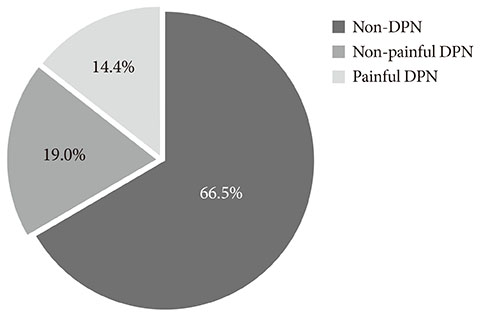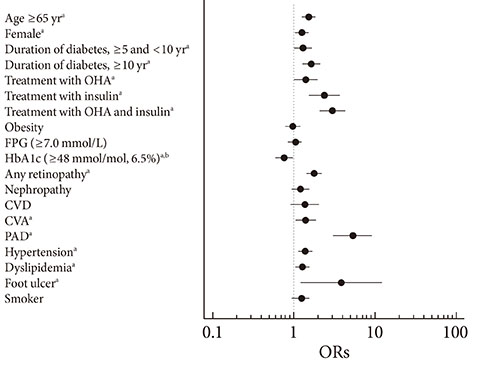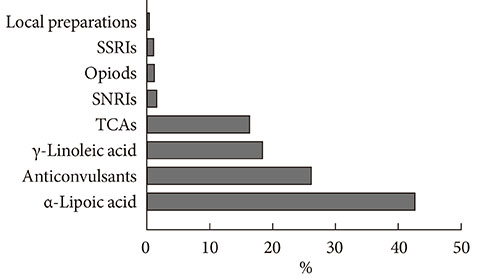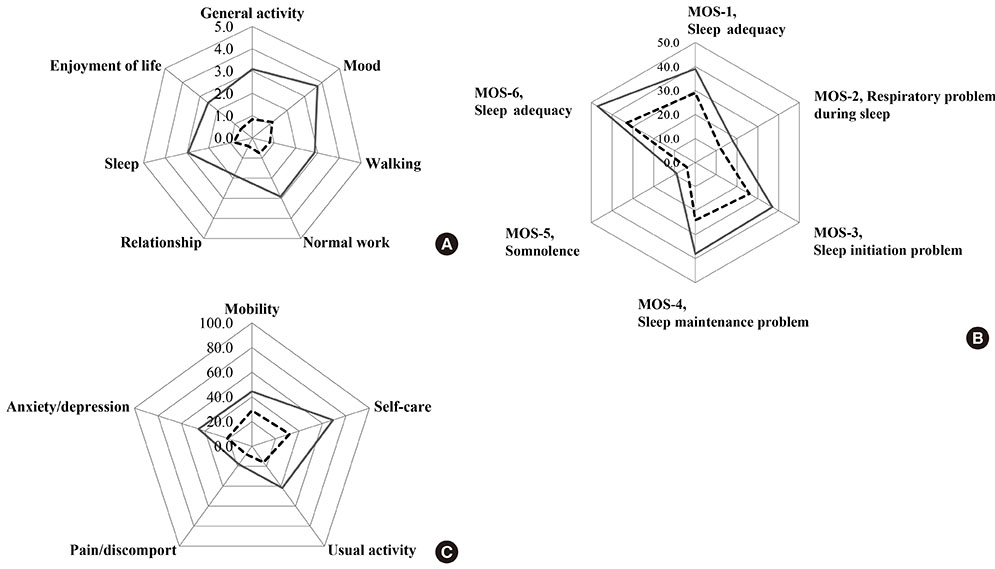Diabetes Metab J.
2014 Feb;38(1):25-31. 10.4093/dmj.2014.38.1.25.
Current Status of Diabetic Peripheral Neuropathy in Korea: Report of a Hospital-Based Study of Type 2 Diabetic Patients in Korea by the Diabetic Neuropathy Study Group of the Korean Diabetes Association
- Affiliations
-
- 1Department of Internal Medicine, Cardiovascular and Metabolic Disease Centre, Inje University College of Medicine, Seoul, Korea. kskomd@paik.ac.kr
- 2Department of Internal Medicine, Pusan National University Hospital, Pusan National University School of Medicine, Busan, Korea.
- 3Department of Internal Medicine, The Catholic University of Korea College of Medicine, Seoul, Korea.
- KMID: 2174181
- DOI: http://doi.org/10.4093/dmj.2014.38.1.25
Abstract
- Diabetic peripheral neuropathy (DPN) is the most common complication associated with diabetes. DPN can present as a loss of sensation, may lead to neuropathic ulcers, and is a leading cause of amputation. Reported estimates of the prevalence of DPN vary due to differences in study populations and diagnostic criteria. Furthermore, the epidemiology and clinical characteristics of DPN in Korean patients with type 2 diabetes mellitus (T2DM) are not as well understood as those of other complications of diabetes such as retinal and renal disease. Recently, the Diabetic Neuropathy Study Group of the Korean Diabetes Association (KDA) conducted a study investigating the impact of DPN on disease burden and quality of life in patients with T2DM and has published some data that are representative of the nation. This review investigated the prevalence and associated clinical implications of DPN in Korean patients with diabetes based on the KDA study.
MeSH Terms
Figure
Cited by 3 articles
-
Effect of Socio-Economic Status on the Prevalence of Diabetes
Yu Jeong Kim, Ja Young Jeon, Seung Jin Han, Hae Jin Kim, Kwan Woo Lee, Dae Jung Kim
Yonsei Med J. 2015;56(3):641-647. doi: 10.3349/ymj.2015.56.3.641.Diagnosis and Management of Diabetic Peripheral Neuropathy
Seong-Su Moon
J Korean Diabetes. 2018;19(3):153-159. doi: 10.4093/jkd.2018.19.3.153.Clinical Importance of Diabetic Neuropathy
Tae Sun Park
J Korean Diabetes. 2018;19(3):147-152. doi: 10.4093/jkd.2018.19.3.147.
Reference
-
1. Kim DJ. The epidemiology of diabetes in Korea. Diabetes Metab J. 2011; 35:303–308.2. U.K. Prospective Diabetes Study Group. Quality of life in type 2 diabetic patients is affected by complications but not by intensive policies to improve blood glucose or blood pressure control (UKPDS 37). Diabetes Care. 1999; 22:1125–1136.3. Candrilli SD, Davis KL, Kan HJ, Lucero MA, Rousculp MD. Prevalence and the associated burden of illness of symptoms of diabetic peripheral neuropathy and diabetic retinopathy. J Diabetes Complications. 2007; 21:306–314.4. Gregg EW, Sorlie P, Paulose-Ram R, Gu Q, Eberhardt MS, Wolz M, Burt V, Curtin L, Engelgau M, Geiss L. 1999-2000 national health and nutrition examination survey. Prevalence of lower-extremity disease in the US adult population >=40 years of age with and without diabetes: 1999-2000 national health and nutrition examination survey. Diabetes Care. 2004; 27:1591–1597.5. Adler AI, Boyko EJ, Ahroni JH, Stensel V, Forsberg RC, Smith DG. Risk factors for diabetic peripheral sensory neuropathy. Results of the Seattle Prospective Diabetic Foot Study. Diabetes Care. 1997; 20:1162–1167.6. Boulton AJ, Vinik AI, Arezzo JC, Bril V, Feldman EL, Freeman R, Malik RA, Maser RE, Sosenko JM, Ziegler D. American Diabetes Association. Diabetic neuropathies: a statement by the American Diabetes Association. Diabetes Care. 2005; 28:956–962.7. Vinik AI, Park TS, Stansberry KB, Pittenger GL. Diabetic neuropathies. Diabetologia. 2000; 43:957–973.8. Pecoraro RE, Reiber GE, Burgess EM. Pathways to diabetic limb amputation. Basis for prevention. Diabetes Care. 1990; 13:513–521.9. Task Force Team for Basic Statistical Study of Korean Diabetes Mellitus of Korean Diabetes Association. Park IeB, Kim J, Kim DJ, Chung CH, Oh JY, Park SW, Lee J, Choi KM, Min KW, Park JH, Son HS, Ahn CW, Kim H, Lee S, Lee IB, Choi I, Baik SH. Diabetes epidemics in Korea: reappraise nationwide survey of diabetes "diabetes in Korea 2007". Diabetes Metab J. 2013; 37:233–239.10. Won JC, Ko KS. The epidemiology of diabetic neuropathy in Korea. Korean Clin Diabetes. 2010; 11:177–183.11. Won JC, Kwon HS, Kim CH, Lee JH, Park TS, Ko KS, Cha BY. Prevalence and clinical characteristics of diabetic peripheral neuropathy in hospital patients with type 2 diabetes in Korea. Diabet Med. 2012; 29:e290–e296.12. Kim SS, Won JC, Kwon HS, Kim CH, Lee JH, Park TS, Ko KS, Cha BY. Validity of the medical outcomes study sleep scale in patients with painful diabetic peripheral neuropathy in Korea. J Diabetes Invest. 2013; 4:405–409.13. Kim SS, Won JC, Kwon HS, Kim CH, Lee JH, Park TS, Ko KS, Cha BY. Prevalence and clinical implications of painful diabetic peripheral neuropathy in type 2 diabetes: results from a nationwide hospital-based study of diabetic neuropathy in Korea. Diabetes Res Clin Pract. 2013; 12. 25. Epub http://dx.doi.org/10.1016/j.diabres.2013.12.003.14. Tapp RJ, Shaw JE, de Courten MP, Dunstan DW, Welborn TA, Zimmet PZ. AusDiab Study Group. Foot complications in Type 2 diabetes: an Australian population-based study. Diabet Med. 2003; 20:105–113.15. Lu B, Yang Z, Wang M, Yang Z, Gong W, Yang Y, Wen J, Zhang Z, Zhao N, Zhu X, Hu R. High prevalence of diabetic neuropathy in population-based patients diagnosed with type 2 diabetes in the Shanghai downtown. Diabetes Res Clin Pract. 2010; 88:289–294.16. Tesfaye S, Boulton AJ, Dyck PJ, Freeman R, Horowitz M, Kempler P, Lauria G, Malik RA, Spallone V, Vinik A, Bernardi L, Valensi P. Toronto Diabetic Neuropathy Expert Group. Diabetic neuropathies: update on definitions, diagnostic criteria, estimation of severity, and treatments. Diabetes Care. 2010; 33:2285–2293.17. Cheng WY, Jiang YD, Chuang LM, Huang CN, Heng LT, Wu HP, Tai TY, Lin BJ. Quantitative sensory testing and risk factors of diabetic sensory neuropathy. J Neurol. 1999; 246:394–398.18. Feldman EL, Stevens MJ, Thomas PK, Brown MB, Canal N, Greene DA. A practical two-step quantitative clinical and electrophysiological assessment for the diagnosis and staging of diabetic neuropathy. Diabetes Care. 1994; 17:1281–1289.19. Boulton AJ, Gries FA, Jervell JA. Guidelines for the diagnosis and outpatient management of diabetic peripheral neuropathy. Diabet Med. 1998; 15:508–514.20. Whiting DR, Guariguata L, Weil C, Shaw J. IDF diabetes atlas: global estimates of the prevalence of diabetes for 2011 and 2030. Diabetes Res Clin Pract. 2011; 94:311–321.21. Abbott CA, Malik RA, van Ross ER, Kulkarni J, Boulton AJ. Prevalence and characteristics of painful diabetic neuropathy in a large community-based diabetic population in the U.K. Diabetes Care. 2011; 34:2220–2224.22. Daousi C, MacFarlane IA, Woodward A, Nurmikko TJ, Bundred PE, Benbow SJ. Chronic painful peripheral neuropathy in an urban community: a controlled comparison of people with and without diabetes. Diabet Med. 2004; 21:976–982.23. Tesfaye S, Chaturvedi N, Eaton SE, Ward JD, Manes C, Ionescu-Tirgoviste C, Witte DR, Fuller JH. EURODIAB Prospective Complications Study Group. Vascular risk factors and diabetic neuropathy. N Engl J Med. 2005; 352:341–350.24. el-Shazly M, Abdel-Fattah M, Scorpiglione N, Benedetti MM, Capani F, Carinci F, Carta Q, Cavaliere D, De Feo EM, Taboga C, Tognoni G, Nicolucci A. The Italian Study Group for the Implementation of the St. Vincent Declaration. Risk factors for lower limb complications in diabetic patients. J Diabetes Complications. 1998; 12:10–17.25. Franklin GM, Shetterly SM, Cohen JA, Baxter J, Hamman RF. Risk factors for distal symmetric neuropathy in NIDDM. The San Luis Valley Diabetes Study. Diabetes Care. 1994; 17:1172–1177.26. Pop-Busui R, Sima A, Stevens M. Diabetic neuropathy and oxidative stress. Diabetes Metab Res Rev. 2006; 22:257–273.27. Clarke PM, Gray AM, Briggs A, Farmer AJ, Fenn P, Stevens RJ, Matthews DR, Stratton IM, Holman RR. UK Prospective Diabetes Study (UKDPS) Group. A model to estimate the lifetime health outcomes of patients with type 2 diabetes: the United Kingdom Prospective Diabetes Study (UKPDS) Outcomes Model (UKPDS no. 68). Diabetologia. 2004; 47:1747–1759.28. Korean Diabetes Association. 2011 Treatment guideline for type 2 diabetes. 4th ed. Seoul: Korean Diabetes Association;2011.29. Dworkin RH, O'Connor AB, Backonja M, Farrar JT, Finnerup NB, Jensen TS, Kalso EA, Loeser JD, Miaskowski C, Nurmikko TJ, Portenoy RK, Rice AS, Stacey BR, Treede RD, Turk DC, Wallace MS. Pharmacologic management of neuropathic pain: evidence-based recommendations. Pain. 2007; 132:237–251.30. Jensen MP, Chodroff MJ, Dworkin RH. The impact of neuropathic pain on health-related quality of life: review and implications. Neurology. 2007; 68:1178–1182.31. Gore M, Brandenburg NA, Hoffman DL, Tai KS, Stacey B. Burden of illness in painful diabetic peripheral neuropathy: the patients' perspectives. J Pain. 2006; 7:892–900.32. Boulton AJ, Vileikyte L, Ragnarson-Tennvall G, Apelqvist J. The global burden of diabetic foot disease. Lancet. 2005; 366:1719–1724.





